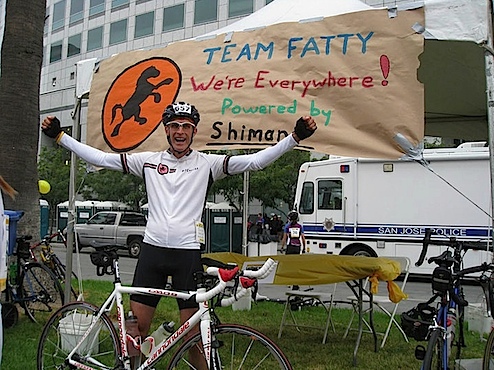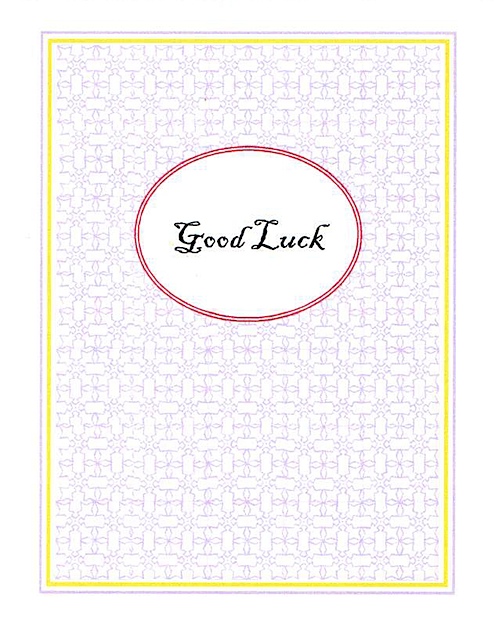05.26.2011 | 9:18 am
A Note from Fatty About Tuesday’s Post: My “Team Fatty in Bizarro World” post on Tuesday caused a little more heat than I intended. I thought of it as a “joke with a tweak:” mostly kidding around, but hey, this is really how people identify Team Fatty at this kind of ride and I don’t like the confusion. That said, I think Jay’s reply is heartfelt and in the end we’re all working toward making the world better. As in, I wouldn’t even consider taking action against these guys. In fact I just made a donation. (And if they’d like to make an in-kind donation at my LiveStrong Challenge page, that would be an awesome way to say, “Hey, no hard feelings.”)
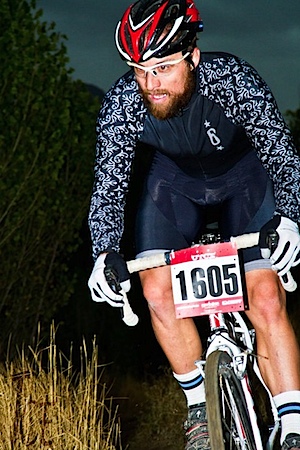 A Note from Fatty About Today’s Post: My friend Adam Lisonbee (Grizzly Adam to all his friends) is a great photographer. Recently I told him about something that bothers me about a lot of the photos I take while biking (both road and mountain): steep trails / roads look like they’re practically flat in my photos. I figured I am not the only person with that problem, so asked him to write a guest post for me. Which is what you’re about to read.
A Note from Fatty About Today’s Post: My friend Adam Lisonbee (Grizzly Adam to all his friends) is a great photographer. Recently I told him about something that bothers me about a lot of the photos I take while biking (both road and mountain): steep trails / roads look like they’re practically flat in my photos. I figured I am not the only person with that problem, so asked him to write a guest post for me. Which is what you’re about to read.
How to Make Steep Hills Look Steep
We’ve all been there.
We skipped the rest stop on the group ride so we could get out ahead of our riding buddies, tossed the bike into the bushes haphazardly, grabbed the camera from our jersey pocket, quickly turned it on and tried to get into that perfect spot to take the perfect photo. The photo that will capture the incredible ability of the riders as they gracefully glide over a mind-bendingly steep trail. You clicked the shutter just in time to capture your companions in what you were absolutely certain would be an amazing picture.
“Did you see how steep that was!”
“I can’t believe I finally rode that section.”
“I got some great photos of you coming down.”
And then you get home and open the pictures on your computer.
And that’s when you realize that, although nice, the photos are lacking something vital. That they are flat. That steep hill looks tame and normal and… “It’s way steeper than that!”
Take the photo below, for example. These ‘cross racers are on a pretty steep run-up. But it looks flat:
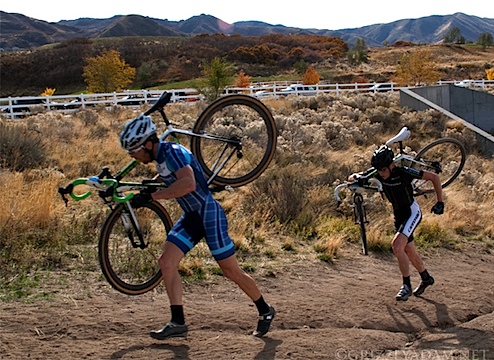
Camera lenses flatten terrain features. It’s one of the shortcomings of taking a three-dimensional landscape and representing it with a two-dimensional photograph.
However, all is not lost. Camera lenses are easily manipulated. You don’t have to be a professional photographer to capture pictures that look a lot better than reality. In fact, that’s what photographers do-they make reality look really, really cool. And you can do it as well. It’s easy!
I’m going to share with you a super-secret secret that will help you capture those “look at how steep this trail is” moments. Now, I specifically chose to share this secret here at FatCyclist.com because I know that Fatty has a large audience, but also an audience that will keep this super-secret secret to yourselves. You won’t just go blabbing it all over Facebook and Twitter. Will you? That’s what I thought. My secret is safe with you.
Oh, and I’m going to give this information to you for free. I could charge you for it, and I know you’d pay. But I’m giving it away for nothing, because, frankly, I’m tired of seeing all the mediocre bike photos that are appearing on the web.
Are you ready? The secret is unbelievably simple.
Just tilt the camera.
I know, I know, right now you are slapping your foreheads and exclaiming loudly (much to the wonderment of your coworkers) “Of course! I’ve been so stupid!”
Tilting your camera will turn even a mundane park trail into a hair-raising, death-defying, gravity-denying, decline.
Just look!
No tilt:
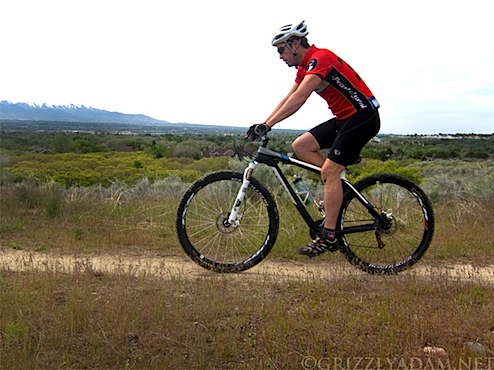
Lots of tilt:
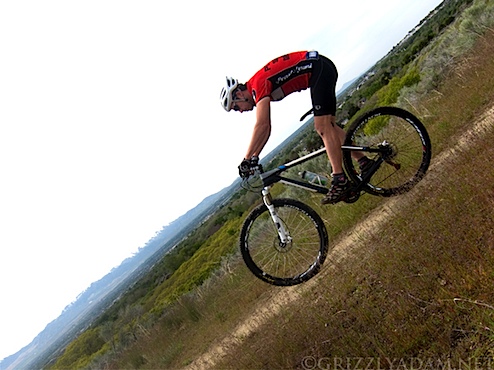
With just the slightest tip of the lens, you can make crazy-scary looking photos. Think of the bragging rights you will own when your coworkers, who probably spent the weekend doing yard work, see pictures of you like the one above. You’ll be the talk of the office!
You can thank me now. Or later. Either is fine. All I ask is that you get out there on your bikes and with your cameras and start shooting tilted pictures. It is, obviously, the only real way to overcome the mountain-flattening shortcomings inherent in the primitive technology of photography.
Oh, and your welcome.
No, Seriously
Wait what? Oh. You wanted actual advice on shooting steep trails? Um.
OK. Let me google that. Hang on a minute.
All right. Here we go. Wait, no. Maybe this one…
This might take a minute. (Fatty, you told me that your audience just wanted razor sharp wit. I didn’t think actual advice was of any value here!)
Ahh. Here we go. Found it.
You want real advice? I’ll give you real advice…
…that I solicited from outdoor photographer extraordinaire, mountain biker, skier, and purveyor of PhotographyReview.com, John Shafer — aka Photo-John.
He says…
First: “Shoot perpendicular. Instead of shooting up at our subject, shoot from the side. This gives you the actual angle. Make sure to watch the trees and keep your camera vertical. If your slope isn’t actually very steep, this may not be the best method.”
Second: “Shoot across. I love it when I can shoot across a ravine or gully with a long lens. The combination of looking straight across at your subject and the long lens can make a slope look nearly vertical. This is a good technique for making things look steeper. The tough part is actually having a good vantage point for a shot like this. I think it’s easier with super long lenses and ski shots than it is for mountain bike photos. I also think telephoto shots in general imply slope better – as long as you stay reasonably close to the subject. If you’re 200 yards straight downhill you’re just going to flatten out the slope. But if you’re 30 feet downhill you can still get a sense of steepness.”
Third: “Wide-angle. Shooting tight with a super wide lens and keeping your subject near the top of the frame can make a trail look really steep and gnarly.”
Hmm. So maybe tilting the camera isn’t the ideal solution. In fact, maybe it’s cheating. To find out for certain, I set out with my camera, and John’s suggestions, in my pocket. The results? Well, I’ll let you decide. But I thought they were a good start. No tilting needed.
Perpendicular sample:
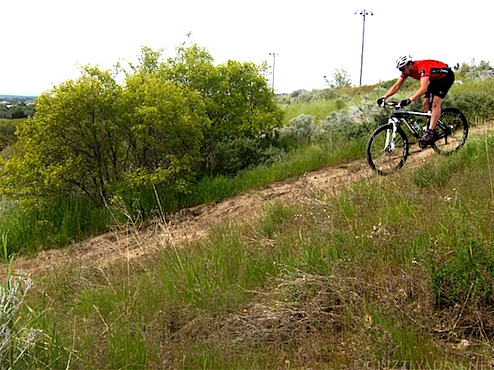
Telephoto samples:
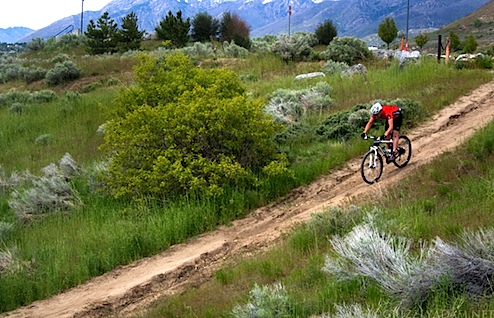
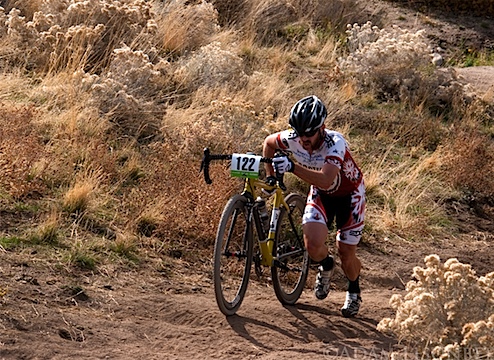
Wide angle sample:
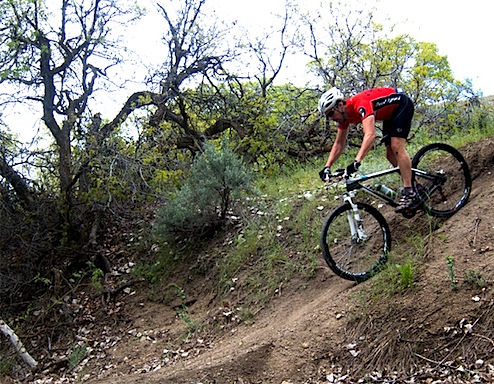
Now it’s your turn. Go ride your bike, and take some great photos along the way.
Grizzly Adam is the author of Mythical and Tangible: Tales of Life, Liberty and the Pursuit of Singletrack. He writes regularly at GrizzlyAdam.net. He can also be found on Twitter.
Comments (19)
05.24.2011 | 11:00 am
I recently stumbled upon a nice photo of a whole bunch of people, all in Team Fatty kit. Check it out:
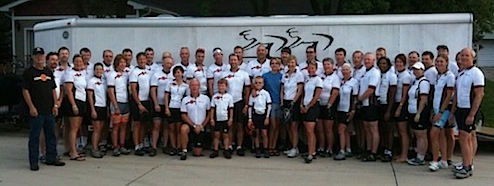
Say, that’s a good-sized group of people wearing the Fat Cyclist jersey! Awesome.
But…hey. Waitasec. Upon closer inspection, I’m not sure those people are part of Team Fatty! And, is it possible that those aren’t Team Fatty jerseys? Let’s take a closer look at a couple of those people:
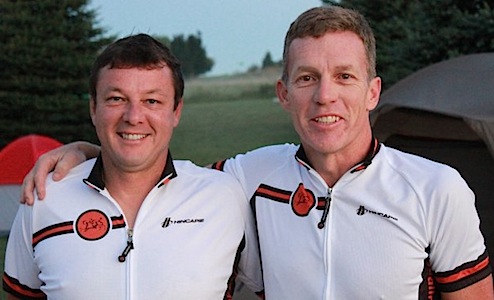
Yeah, something weird is going on here. For one thing, instead of “FatCyclist.com” over the left breast, those jerseys say “Hincapie.” Even weirder, that’s definitely not the distinctive Rearing Clydesdale inside the orange circle. But otherwise, it looks a lot like my jersey. You know, the one that looks like this:
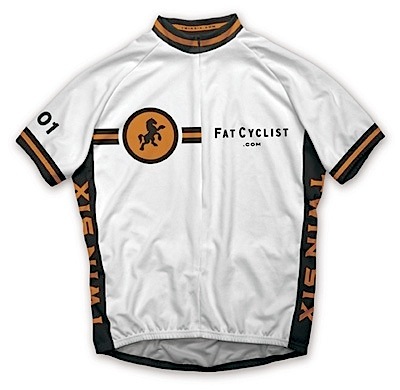
Collar’s the same, sleeves are the same, stripes are the same, colors are the same.
It’s eerie. Almost as if someone has taken the hard work that Twin Six does, along with the meaning that my blog gives to this look, and took it, without permission.
But you know, maybe I’m not being fair. Probably that jersey only looks the same as mine from the front. I’ll bet the design from the rear is totally different. For example, here’s what the back of my 2010 jersey looks like:
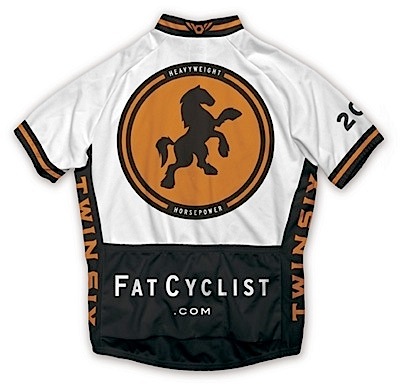
And here’s theirs:
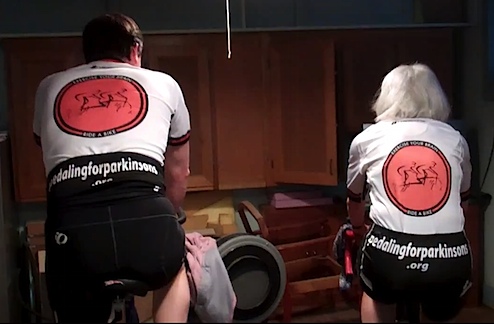
See? Totally different, as long as by “totally different” you mean “swap out the horse for a sketch of people riding a tandem, swap out the text for other text, and swap out the URL for your own URL.”
Ah, so it looks like the folks at pedalingforparkinsons.org stole my jersey design. And by “stole,” I mean “Took it without asking, nor ever made any acknowledgement to me or Twin Six of what they were doing.”
Implications
Honestly, it’s incredibly inspirational to see the work Twin Six did for me so “faithfully replicated,” and to know that it’s totally cool to, you know, just kinda take stuff. Without asking. Because I’ve been thinking of branching my product line out a bit, and this really simplifies the design work and permissions process. For example, I think you’ll all really like the coffee I’ll be selling:

And my very own line of automobiles:
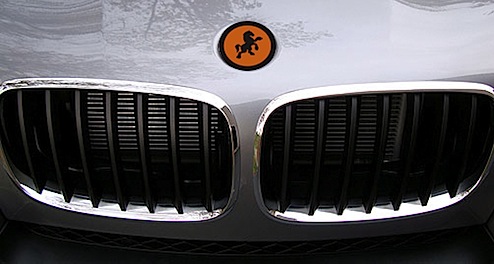
And I’m going to be having a Pro Cycling Team!

Congratulations, by the way, to my team for taking first and second in my new race, the Fat Cyclist Tour of California.
Of course, you’ll be able to buy all this merchandise at the new Fat Cyclist / Target Store:

I’ll bet that’s a really awesome place to buy a nice, cold drink:
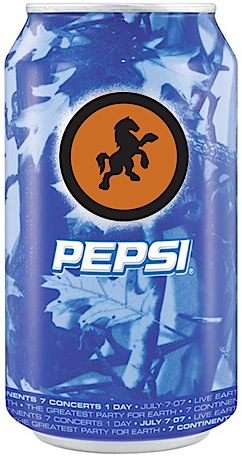
PS: Good luck at RAGBRAI 2011, Bizarro World Team Fatty!
Comments (111)
05.23.2011 | 1:30 pm
I had a beautiful plan for training for and racing the 2011 Ogden Marathon. And that plan was, “pretend like it’s not really going to happen.”
And I followed that plan to a T. Which is to say, ever since completing (more or less) the NYC Marathon, I haven’t run more than once a week. And when I’ve run, it’s usually been for between three and six miles. Until a week ago or so, when The Runner made me go out on a nine-mile trail run, to see whether I had a chance of surviving the marathon at all.
I finished feeling OK, but we both knew that what mattered for this particular race was that she do well. We’d start together (with me way too far in front for where I really belonged), I’d do my best to run with her for the first mile, and then she’d wait for me for an hour or so at the finish line.
It was a good plan.
The Day Before the Race
Then, on Friday morning — the day before the race — I woke up with a sore throat. I know the difference between sore throats due to a night of open-mouth snoring (I’m afraid I get those all too often) and a sore throat due to a cold. This was definitely a cold.
Perfect.
I didn’t honestly care very much on my own behalf whether I had a cold. I’ve had colds before during races and I know that I can pretty much push through them. In fact, while I’m exercising a lot of the cold symptoms will disappear.
But I did care about The Runner catching my cold. This race was to be the marathon she used to qualify for the 2012 Boston Marathon. She couldn’t be running it with a cold.
Knowing that The Runner was already dealing with pre-race jitters and had enough on her mind, I made an executive decision: I would not tell her I had a cold, but would instead try to keep my contagion to myself (literally and mentally).
So I consciously washed my hands constantly, and stopped the newlywed handholding and such. When The Runner asked if I was OK, I just told her I was preoccupied with the race.
Meanwhile, I couldn’t breathe and I felt like I had a fever.
Finally, about 9:00pm, The Runner (aka The Nurse) said, “Something’s wrong with you. Tell me what it is.”
“OK,” I said, “I’ve got a cold.”
“Well, hopefully I won’t catch it by tomorrow morning,” she said, since she is a rational adult.
I set the alarm clock for 3:45, we each took 2.5mg of Ambien, I blew my nose about a hundred times (strangely and helpfully, our schwag bags included full-size boxes of Kleenex), and we were gone.
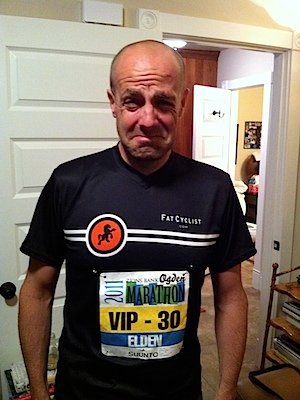 Race Prep
Race Prep
Here’s a shocker: I don’t like waking up at 3:45am. When you’re awakened at that time, your mind races and you can’t help but briefly think it must be because of an emergency.
Then you remember: it’s because you’re going to be racing soon.
And then you wish you could go back to having been awakened because it’s an emergency.
At least I didn’t feel as awful as I had Friday night. My throat was still sore, but just in a background way. I wasn’t coughing, and while my nose was all stuffed up, I knew that would clear up and stay clear when I started running.
Also, for the first time in what seems like forever, we had a forecast for good weather. Partly sunny, mid-60s. Not much wind.
I suited up: the fantastic Pearl Izumi shorts, shoe and socks I scored as part of the Team Fatty at NYC adventure last year, along with a Fat Cyclist running shirt, and a long-sleeve shirt I bought at a used clothes store with the intention of discarding it when I passed an aid station.
As we dressed, The Runner gave me an out.
“You don’t have to do this race,” she said. “You haven’t trained, and you’re sick. You’ve got a good excuse.”
I admit: I was tempted. But I know myself well enough to know that I would have spent the day feeling miserable, hating myself for taking the easy way out, wondering how I would have done if I would have toughed it out, and trying to figure out a way to spin quitting into a good story for the blog.”
“I’m going to do it,” I said. “Just don’t be too surprised if you have to wait for a very long time at the finish line.”
The Dubious Perks of Being a VIP
We drove to the general area for where we were supposed to board the buses, parked, and then walked to where we were supposed to board the VIP bus (Read here if you don’t know why we were VIPs).
There was no bus.
We looked around and walked around and then we saw it: down and across the street: our buses. We walked over and got our VIP breakfasts (half a bagel, a cup of apple juice, a packet of Swedish Fish), and were told we could not get on the bus, because they were not sure it was the right bus.
So we waited.
After a few minutes, we were told to walk to a third location, which — due to some confusion — is where our buses actually were. We did, and got onto our bus.
Then, five minutes later, we were told that this, too, was not our actual bus, and that we needed to get on yet a different bus.
This, as it turned out, was in fact the actual bus.
We sat down and I ate my Swedish Fish. I like candy.
A final note on the bus and our VIP-ness: I have never tried to use a back-of-the-bus potty before, but found to my surprise that a surprising amount of heat flows upward from the toilet itself, perhaps as a disincentive to hang around and read the newspaper.
The Last I See of The Runner
As we stood in line, waiting for the run to begin, I reviewed the plan the Runner had put together for me to survive this marathon. It will help to refer to the elevation profile:

The first seven miles, she told me, are downhill. I should try to imagine coasting for this part of the race, letting gravity carry me down, and try not to walk for anything but a quick drink and something to eat.
From mile seven to twenty, she told me, the course would be mostly flat. Here’s where I should put my “mile / minute” tactic into play: run a mile, walk a minute.
Then, finally, the last six miles are primarily downhill. Try to let gravity carry me the best I could.
OK, sounds good.
“I’ll see you in five hours or so,” I told The Runner. “Now go kick this marathon’s butt.”
We started, and my plan to stay with The Runner for the first mile immediately disappeared as she shot forward and nearly out of sight. I stepped up my pace to the redline, caught her, and hollered, “Good luck!” before she dropped me again, this time for good.
That’s OK. The fact that she’s so much faster than me was encouraging. I knew she’d have a good race.
I Settle Into What Will Have to Pass for a Groove
At mile 1, I saw a row of porta-potties. Strangely — for mile 1 anyway — I already need to use one. Ordinarily, I would put it off, thinking that stopping so soon in a race is a terrible idea.
Then I remind myself: I’m not racing, not really. I take care of my business and run back into the fray.
And now I have no idea where in the flow of runners I am. I can no longer see the stick with balloons on it for the 3:30 group, and I suspect the 3:45 group would have passed as well. Who knows, maybe the 4:00 group has, too.
I don’t know, and it doesn’t matter. I don’t have a GPS or even a watch on. I’m just going to go the pace I can go.
I turn on my iPod Shuffle — something I normally don’t use, but I knew I’d be running alone — and try to let gravity carry me.
I watch the raging river beside me. I look at the mountains ahead. I stare at the sky, sunny for the first time in ever.
To my surprise, I’m enjoying myself.
Not until the race results are published do I find that for this first seven mile stretch, I ran an 8:01 pace. About as fast as I’ve ever run, and for sure faster than I’ve ever run more than a mile.
Change of Plans
I don’t feel the need to drink or eat anything when I hit the seven mile marker, which is where the course has leveled off, so I keep going. By mile 9, I’m ready for something. Banana, Powerade. I walk from the beginning to the end of the aid station as I eat, and then I’m off again.
By mile 10, my nips are hurting. I know what this means, and what I should have done to prevent this problem. Oh well, nothing to do but keep going.
I eat and walk again at mile 11, this time Powerade and an energy gel.
From then on, I walk every aid station, drinking a cup of Powerade and alternating a banana and energy gel. I know what works for me; my stomach never complains the whole run or after.
We ran around a lake in the country, the sun warm, the air calm. I hit the 13th mile — the halfway point — feeling just fine, enjoying the view, taking my time.
I did not know I was — on this fairly flat section of the course — running at an 8:48 pace. Had I known, I would have panicked and backed off, thinking I was heading for a full-on meltdown.
But the meltdown never came.
At mile 15, I was not at all surprised when a group caught me and then surged by — I had been being passed by people all day.
What did surprise me, though, was that this was the group hanging with the 3:45 pace runner.
What?
I was 15 miles into a run and was just now being passed by the 3:45 group?
Suddenly, my objective changed. I no longer wanted to finish when I finished. I wanted to surprise The Runner by crossing the line a full hour faster than either of us expected me to.
On the spot, I decided I would do my best to hang with the 3:45 group for a mile or two, then let them ease away, but slowly, with the intent of letting them put about a minute per mile on me for the rest of the race.
If I could do that, I’d be looking at a 3:57 finish, maybe 3:58 if I started hurting toward the end.
Oh The Pain
As I told myself I would, I hung onto the 3:45 group ’til somewhere past the mile 16 marker. Then they dropped me, not so much because I let them go as because there was nothing I could do but let them go.
I chugged along, entertaining myself with how surprised The Runner would be when I finished in four hours instead of five.
By mile 17, though, it was obvious that relative to everyone around me, I was slowing down. Group after group caught and passed me. Few people talking. Only energy for moving forward.
A group of 10-12 runners engulfed me. All of them women. I wondered, briefly, if my male ego should feel injured by this. I decided that, as a man whose wife was probably two miles ahead of him at that moment, it should not.
I hit mile 20, which is when the road turns down again.
And that hurt. A lot.
Mostly the constant pounding hurt my quads, except for maybe it hurt my calves more. And also the jarring hurt my back. And my neck, too. Oh, and my nips. Especially my nips. I was pretty sure I had rubbed them clean off. And if you look at this picture which I have cleverly not embedded in the main story body because it is a very disturbing image, you will see that I had, in fact, pretty much rubbed them completely off.
OK, I was hurting everywhere.
I noticed, though, people were stopping and walking. Stretching. Clearly trying to cope with pain of their own.
Somehow, knowing that the pain was just part and parcel of the course — not something I alone was experiencing — made it easier to cope with. I may have been hurting, but at least I wasn’t being hurt unfairly.
I started thinking more and more about The Runner. How was her race going? Was she going to finish with a qualifying time? Was her hip bothering her?
The sooner I finished the race, the sooner I’d know. That spurred me on. As it turns out, from mile 20-23, I ran an 8:47 pace.
Meanwhile, I devised a clever trick to help me make it from one mile to the next. I called it, “Three songs is a mile.”
This game was incredibly helpful, since it took, on average, three songs for me to run a mile. As I got to mile 21, 22, 23, it seemed like the miles stretched on forever; it was useful to be able to tell myself, “No, this is just the second song since the last mile marker. One more song after this one.”
Finally, I was at the last mile. Then the last half. And then I could see the finishing clock. It showed 3:59:20.
I had half a minute.
Without considering that this was showing gun time — not chip time — I broke into the best approximation I could of a sprint, and passed under the Finish line at 3:59:40. Or something like that.
My chip finish time? 3:58:20. I had just run a sub-4-hour marathon. At a 9:06 pace, overall. With a cold.
I could hardly wait to tell The Runner.
Where’s The Runner?
I rushed to the tent where our drop bags were located, got my phone, and called The Runner.
No answer.
I texted her.
No reply.
I went into Panicky Mother Hen Mode. The Runner had not picked up her phone after the race! We had agreed we’d pick up our phones after the race to make it easy to contact and find each other! Does this mean that The Runner had not finished the race?
Was it possible that The Runner was lying in the medical tent at the finish line?
No, I checked.
But she could be in a medical tent on the course!
I ran around in circles, shouting things about the sky falling and stuff.
As it turns out, The Runner had finished her race in 3:41:45, qualifying for the Boston Marathon with time to spare. She just hadn’t picked up her phone yet because she didn’t think there’d be any reason she’d need it for an hour or so.
We found each other, collapsed into chairs, and began telling each other the stories of the day.
A Day Later
Yesterday, we could not make it up the stairs easily, and couldn’t make it down stairs without an assist from the rail. Today’s only a little bit worse. My quads have never hurt so much.
Also, yesterday we signed up for the Death Valley Trail Marathon on December 3 of this year. You should join us. It’ll be fun.
Ha.
Comments (40)

